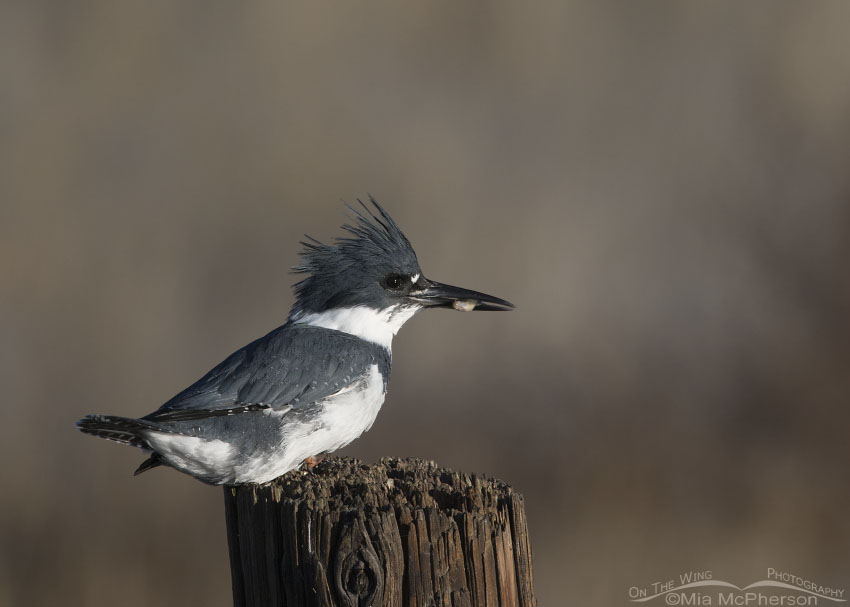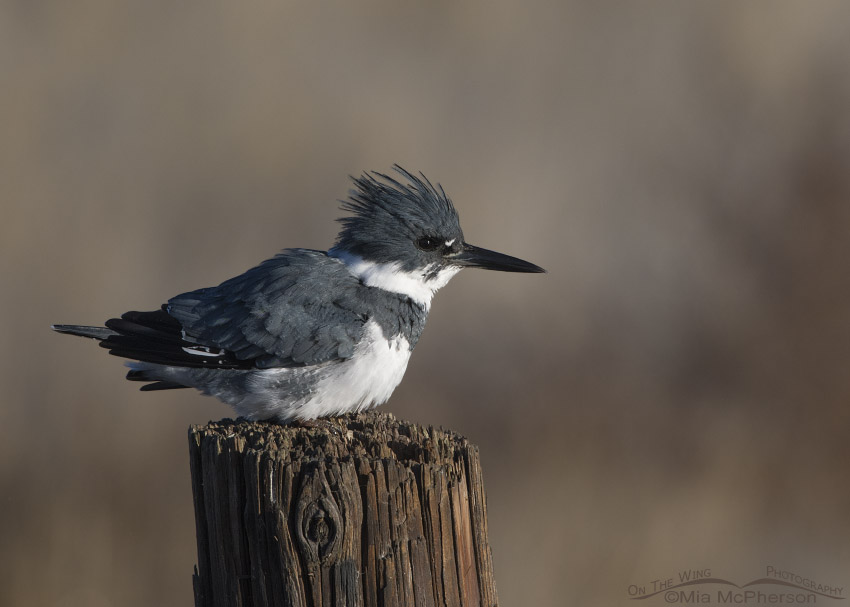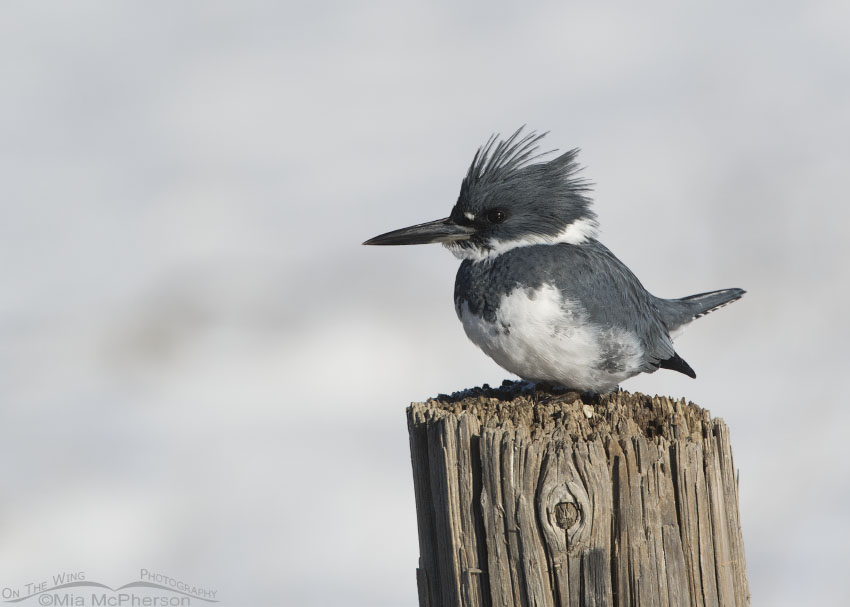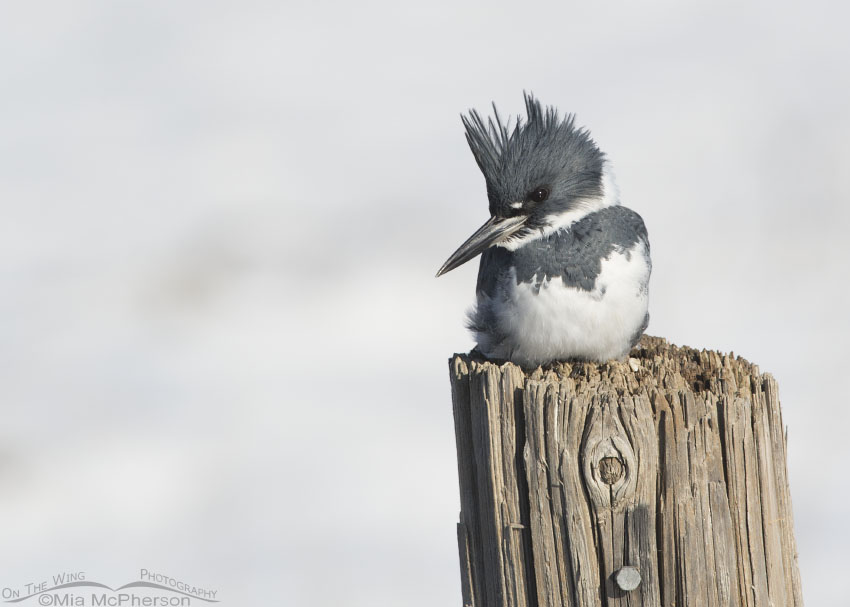Male Belted Kingfisher
 Male Belted Kingfisher with prey in his bill – Nikon D500, f7.1, 1/1600, ISO 320, -1.0 EV, Nikkor 500mm VR with 1.4x TC, natural light, not baited
Male Belted Kingfisher with prey in his bill – Nikon D500, f7.1, 1/1600, ISO 320, -1.0 EV, Nikkor 500mm VR with 1.4x TC, natural light, not baited
We had a real gully washer rain here in the Salt Lake Valley yesterday which we needed badly and it also snowed in the mountains. From the photos I saw up there it looked like winter even though it isn’t. The snow in the high country is just a small taste of what is to come when it is actually winter but it made me think about some of the birds I find, observe and photograph in the northern Utah winters.
Belted Kingfishers are year round residents in northern Utah but my best opportunities to photograph them at Farmington Bay WMA are during the winter. Last December there was a male Belted Kingfisher that hung around the WMA and gave me and many other photographers lots of opportunities to photograph him as he fished, ate, preened, rested and allowed us to capture his beauty.
 Male Belted Kingfisher shaking his feathers – Nikon D500, f7.1, 1/1600, ISO 320, -1.0 EV, Nikkor 500mm VR with 1.4x TC, natural light, not baited
Male Belted Kingfisher shaking his feathers – Nikon D500, f7.1, 1/1600, ISO 320, -1.0 EV, Nikkor 500mm VR with 1.4x TC, natural light, not baited
These first two images were taken on November 22, 2016 when there was no snow on the ground. The kingfisher had a favorite perch by a small stream that he fished in, he could easily see down into the water and would dive after prey when he saw it. These birds will stay in the area until the water ices over and then they move on until they come to open water again. Their primary prey items are fish but they also will eat crustaceans such as crayfish, mollusks, insects, amphibians, reptiles, small birds and small fruits like berries.
 Winter snow and a male Belted Kingfisher – Nikon D500, f8, 1/2000, ISO 320, +0.3 EV, Nikkor 500mm VR with 1.4x TC, natural light, not baited
Winter snow and a male Belted Kingfisher – Nikon D500, f8, 1/2000, ISO 320, +0.3 EV, Nikkor 500mm VR with 1.4x TC, natural light, not baited
These last two images were taken December 2, 2016 when there was a thick blanket of snow on the ground and the kingfisher is on the same perch as the first two photos. The post the bird is perched on looks a but lighter in these photos because it was dry, in the first two images the post had been soaked by rain or melting snow which made it appear darker.
Just looking at these photo allows me to “hear” the rattling call of the Belted Kingfishers that I adore listening to so much even though it usually means the birds are flying away from me at that point. They are skittish subjects.
Listen to the calls of an interacting pair of Belted Kingfishers here.
 Male Belted Kingfisher and snow – Nikon D500, f8, 1/1250, ISO 250, +0.3 EV, Nikkor 500mm VR with 1.4x TC, natural light, not baited
Male Belted Kingfisher and snow – Nikon D500, f8, 1/1250, ISO 250, +0.3 EV, Nikkor 500mm VR with 1.4x TC, natural light, not baited
I hope that this male Belted Kingfisher or another male or female decide to visit and stay at Farmington Bay WMA again this winter because not only are they handsome birds they are quite fun to observe and challenging to photograph. They aren’t there every year so I am keeping my fingers crossed.
Life is good.
Mia
Click here to see more of my Belted Kingfisher photos plus facts and information about this species.


Great series of pics Mia. Such incredible detail; I can never get enough of it.
Patty…my daughters want Thelma’s phone number.
Mia, I especially like the last shot — what a great pose!
Funny, I just stopped to watch a belted kingfisher on my way home near the rail trail in PC.
Love this bird, especially on the wing.
thanks Mia, great shots
Another stunner. I love his do as well.
Beautiful birds. Thank you for posting the sound, I always enjoy listening while I read.
Great shots of an often elusive bird. Lady who cuts my hair, is 97…decided to have a wake and “gone away” party today, while she’s still around to enjoy it. I plan gel my hair like the kingfisher in the last frame did his and wear a . Sign that says, “Thelma does my hair”….
Oh, please take a picture Patty. I would love to see that
Patty, you are hilarious! 😀 I’d pay to see that photo too!
Love these guys! Had the pleasure of photographing one at Jamaica Bay NWR, NY, recently. They have such personality!
Lucky you to get photos of these beautiful birds. To me they are the pranksters of the bird kingdom. It seems that as soon as I have my camera aimed they take off. They just seem to know.
Wow! My favorite bird..thank you.We have a few winter over here on Long Island, NY but VERY elusive..hard to snap! Love your photos!